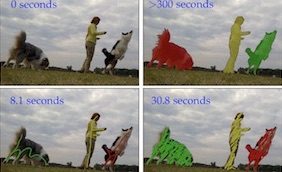Dates and Phases
- Test-Dev 2018: Open end.- Test-Challenge 2018: 13th May 2018 23:59 UTC - 25th May 2018 23:59 UTC.
Papers
- Right after the Challenge closes (26th May) we will invite all participants to submit a short abstract (400 words maximum) of their method (Deadline 29th of May, 23:59 UTC).- Together with the results obtained, we will decide which teams are accepted at the workshop. Date of notification June 1st.
- Accepted teams will be able to submit a paper describing their approach (Deadline 13th June, 23:59 UTC). The template of the paper is the same as CVPR, but length will be limited to 4 pages including references.
- Papers will also be invited to the workshop in form of oral presentation or poster.
- Accepted papers will be self-published in the web of the challenge (not in the official proceedings, although they have the same value).
Datasets (Download here, 480p resolution)
- Train 2017 + Val 2017: 90 sequences, the 50 original DAVIS 2016 sequences (reannotated with multiple objects) plus 40 new sequences. The sequences and ground truth are publicly available as of beginning April 2017.- Test-Dev 2017: 30 new sequences, available as of beginning April 2017. Ground truth not publicly available, unlimited number of submissions.
- Test-Challenge 2017: 30 new sequences, available at the start of the Test-Challenge phase. Ground truth not publicly available, limited to 5 submissions in total.
- Feel free to train or pre-train your algorithms on any other dataset apart from DAVIS (MS COCO, Pascal, etc.) or use the full resolution DAVIS annotations and images.
Submission
Submissions to all phases will be done through the Codalab site of the challenge.Please register to the site and refer to the instructions on how to submit your results.
Prizes
The winner team will receive an NVIDIA Titan Xp GPU as prize. The top five submissions will receive a subscription to Adobe CC for 1 year.Evaluation
- The per-object measures are those described in the original DAVIS CVPR 2016 paper: Region Jaccard (J) and Boundary F measure (F).- The overall ranking measures will be computed as the mean between J and F, both averaged over all objects. Precise definitions available in the paper.


